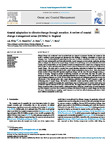Coastal adaptation to climate change through zonation: A review of coastal change management areas (CCMAs) in England
| dc.contributor.author | Kirby, JA | |
| dc.contributor.author | Masselink, Gerd | |
| dc.contributor.author | ESSEX, Stephen | |
| dc.contributor.author | Poate, Tim | |
| dc.contributor.author | Scott, Tim | |
| dc.date.accessioned | 2021-11-23T11:07:07Z | |
| dc.date.available | 2021-11-23T11:07:07Z | |
| dc.date.issued | 2021-12-01 | |
| dc.identifier.issn | 0964-5691 | |
| dc.identifier.issn | 1873-524X | |
| dc.identifier.other | 105950 | |
| dc.identifier.uri | http://hdl.handle.net/10026.1/18401 | |
| dc.description.abstract |
Climate change and accelerated rates in sea-level rise are expected to increase flooding and erosion on the world's coastlines. Coastal managers and planners face the challenge of helping communities to adapt to the changing coast. Traditionally hard engineering has been used to defend communities on the coast, but as this option becomes unsustainable and financially unviable, coastal managers are increasingly employing planning policy to mitigate the risk posed by coastal change. Zonation of coastal change areas and delineation of erosion extents, such as set-back lines, are used globally to restrict development in the coastal zone. In England there is policy in place to allow planning authorities to restrict certain development in areas expected to be affected by coastal change. This study aims to examine how coastal planning authorities in England have implemented coastal change adaptation policies, specifically Coastal Change Management Areas (CCMA). These areas should include sections of coast that will experience significant change over the next 100 years through erosion, accretion or flooding. Through an analysis of planning documents, we have found that since the policy was introduced in 2012, only 15% of coastal planning authorities have designated a CCMA, with just 5.7% of the coast of England designated as a CCMA. We have found that inadequate and ambiguous guidance has reduced the effectiveness of the national policy with coastal planning authorities unsure of which datasets to apply for delineating areas of coastal change. This has led to vulnerable coastal areas being omitted from CCMAs. The datasets that are available for mapping the coastal change areas are found to vary in erosion extent and do not account for expected increases in the rate of sea-level rise. We suggest that for coastal zonation and climate change adaptation policy to be successful, a robust methodology, including a classification of coastal typologies and their response to sea level rise, is needed to delineate the extent of erosion or coastal change over the next 100 years. Understanding and mapping coastal response to sea level rise will aid planning authorities to build more resilient communities on the coast. | |
| dc.format.extent | 105950-105950 | |
| dc.language | en | |
| dc.language.iso | en | |
| dc.publisher | Elsevier | |
| dc.subject | Coastal management | |
| dc.subject | Coastal zonation | |
| dc.subject | Sea-level rise | |
| dc.subject | Coastal adaptation | |
| dc.subject | Climate change | |
| dc.subject | Coastal policy | |
| dc.subject | Coastal erosion | |
| dc.title | Coastal adaptation to climate change through zonation: A review of coastal change management areas (CCMAs) in England | |
| dc.type | journal-article | |
| dc.type | Journal Article | |
| plymouth.author-url | https://www.webofscience.com/api/gateway?GWVersion=2&SrcApp=PARTNER_APP&SrcAuth=LinksAMR&KeyUT=WOS:000714571300005&DestLinkType=FullRecord&DestApp=ALL_WOS&UsrCustomerID=11bb513d99f797142bcfeffcc58ea008 | |
| plymouth.volume | 215 | |
| plymouth.publication-status | Published | |
| plymouth.journal | Ocean and Coastal Management | |
| dc.identifier.doi | 10.1016/j.ocecoaman.2021.105950 | |
| plymouth.organisational-group | /Plymouth | |
| plymouth.organisational-group | /Plymouth/Faculty of Science and Engineering | |
| plymouth.organisational-group | /Plymouth/Faculty of Science and Engineering/School of Biological and Marine Sciences | |
| plymouth.organisational-group | /Plymouth/Faculty of Science and Engineering/School of Geography, Earth and Environmental Sciences | |
| plymouth.organisational-group | /Plymouth/REF 2021 Researchers by UoA | |
| plymouth.organisational-group | /Plymouth/REF 2021 Researchers by UoA/UoA07 Earth Systems and Environmental Sciences | |
| plymouth.organisational-group | /Plymouth/REF 2021 Researchers by UoA/UoA14 Geography and Environmental Studies | |
| plymouth.organisational-group | /Plymouth/Research Groups | |
| plymouth.organisational-group | /Plymouth/Research Groups/Centre for Research in Environment and Society (CeRES) | |
| plymouth.organisational-group | /Plymouth/Research Groups/Centre for Research in Environment and Society (CeRES)/CeRES (Reporting) | |
| plymouth.organisational-group | /Plymouth/Research Groups/Marine Institute | |
| plymouth.organisational-group | /Plymouth/Users by role | |
| plymouth.organisational-group | /Plymouth/Users by role/Academics | |
| plymouth.organisational-group | /Plymouth/Users by role/Researchers in ResearchFish submission | |
| dcterms.dateAccepted | 2021-10-21 | |
| dc.rights.embargodate | 2021-10-28 | |
| dc.identifier.eissn | 1873-524X | |
| dc.rights.embargoperiod | Not known | |
| rioxxterms.funder | Natural Environment Research Council | |
| rioxxterms.identifier.project | South West Partnership for Environment and Economic Prosperity (SWEEP) | |
| rioxxterms.versionofrecord | 10.1016/j.ocecoaman.2021.105950 | |
| rioxxterms.licenseref.uri | http://www.rioxx.net/licenses/all-rights-reserved | |
| rioxxterms.licenseref.startdate | 2021-12-01 | |
| rioxxterms.type | Journal Article/Review | |
| plymouth.funder | South West Partnership for Environment and Economic Prosperity (SWEEP)::Natural Environment Research Council |


